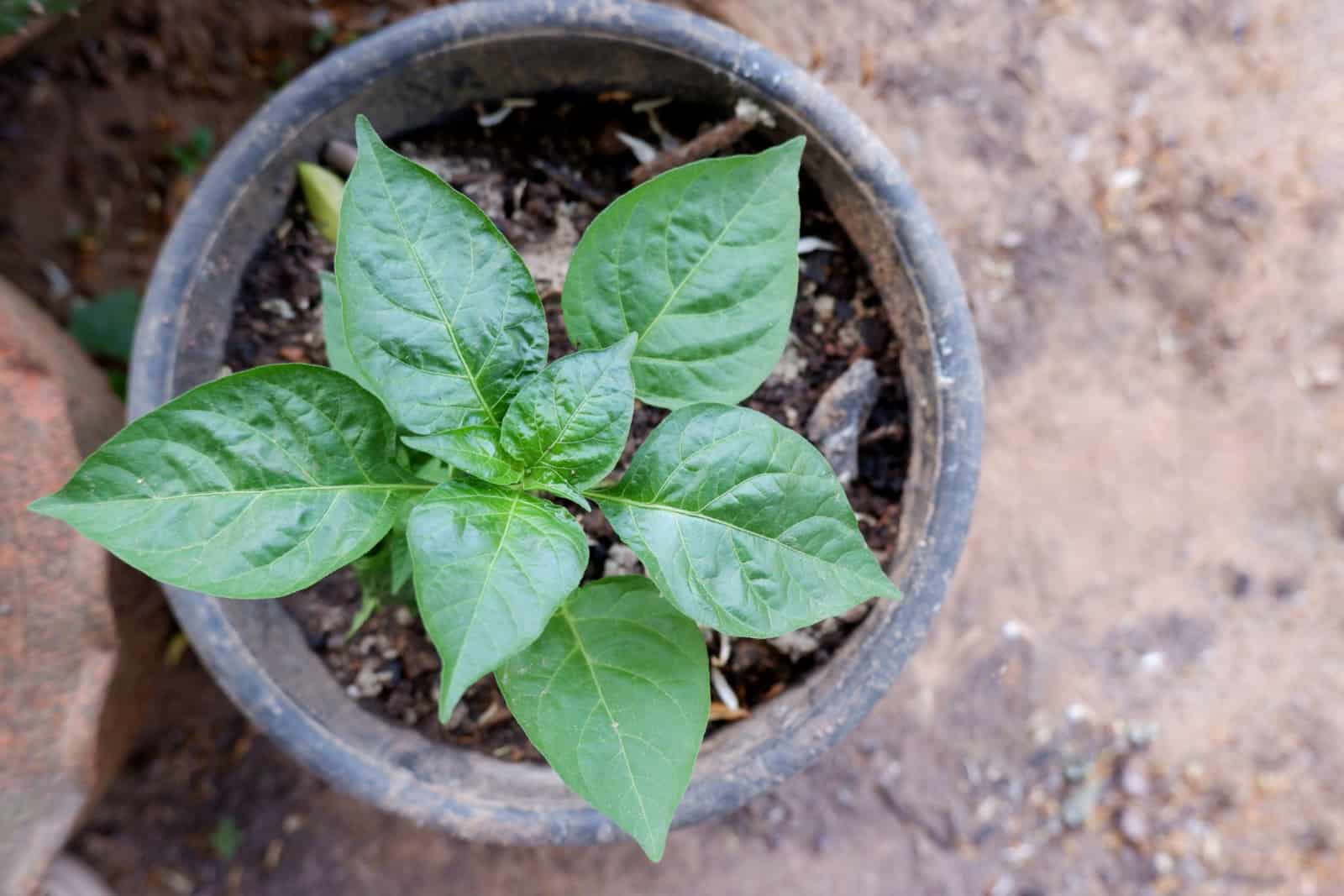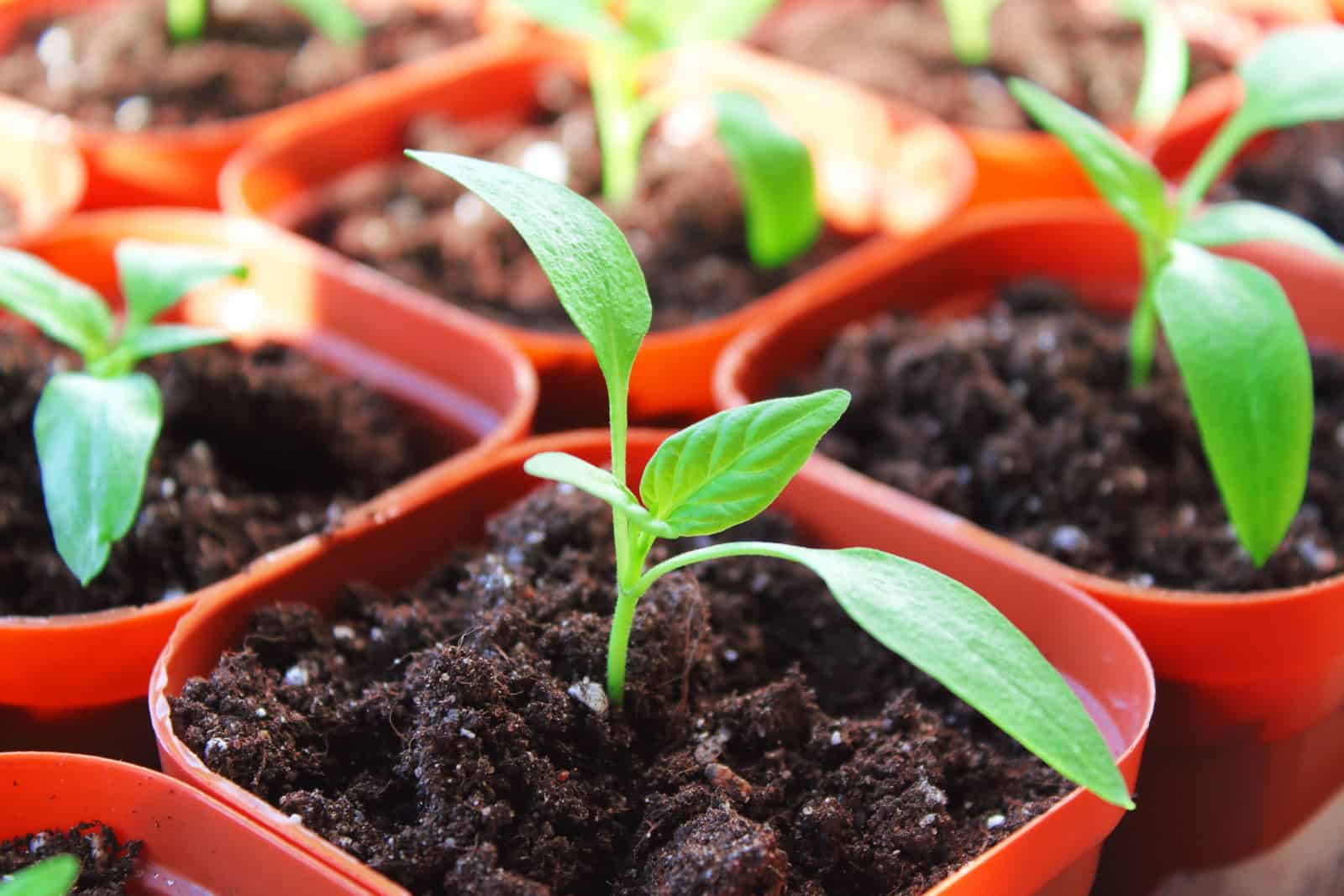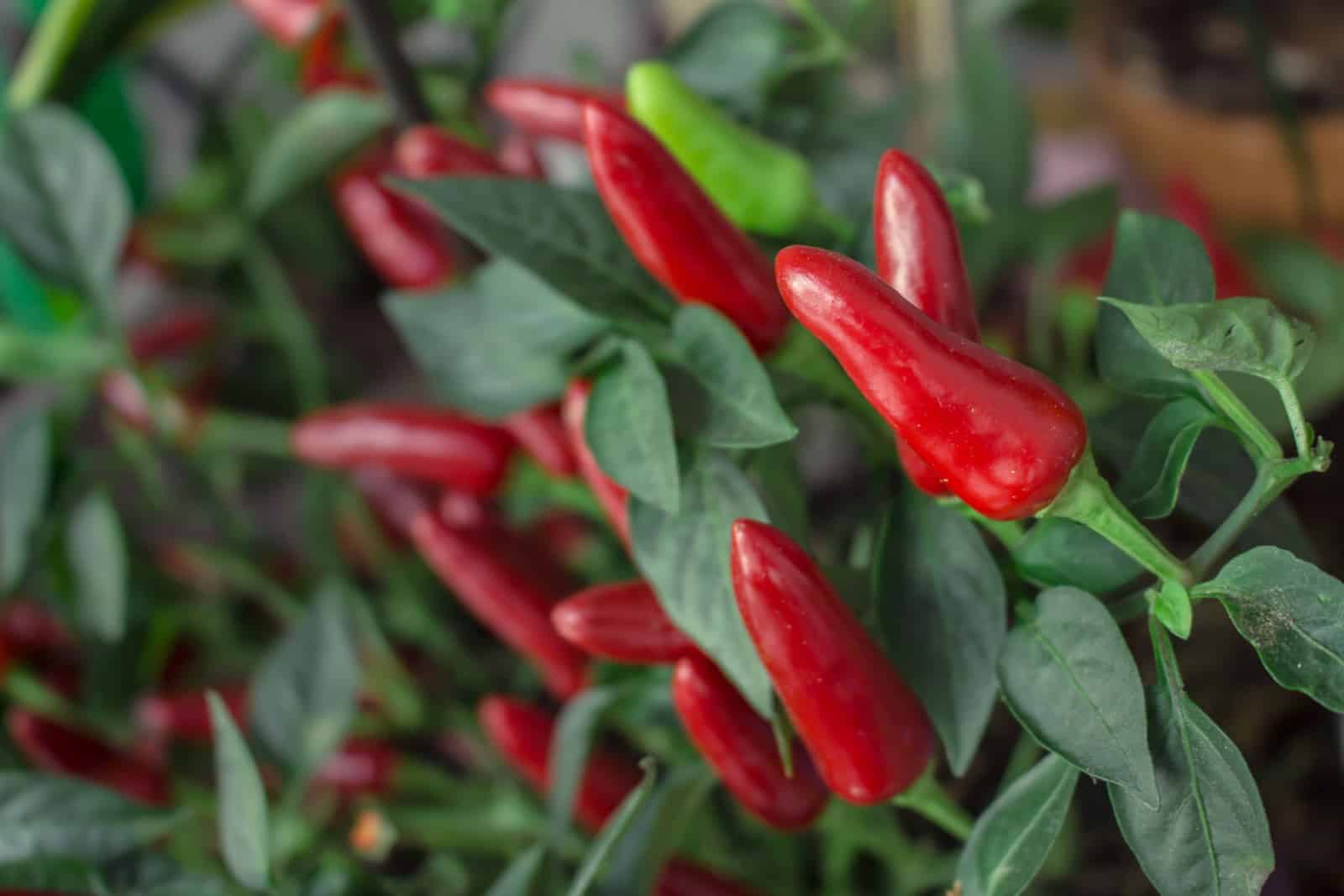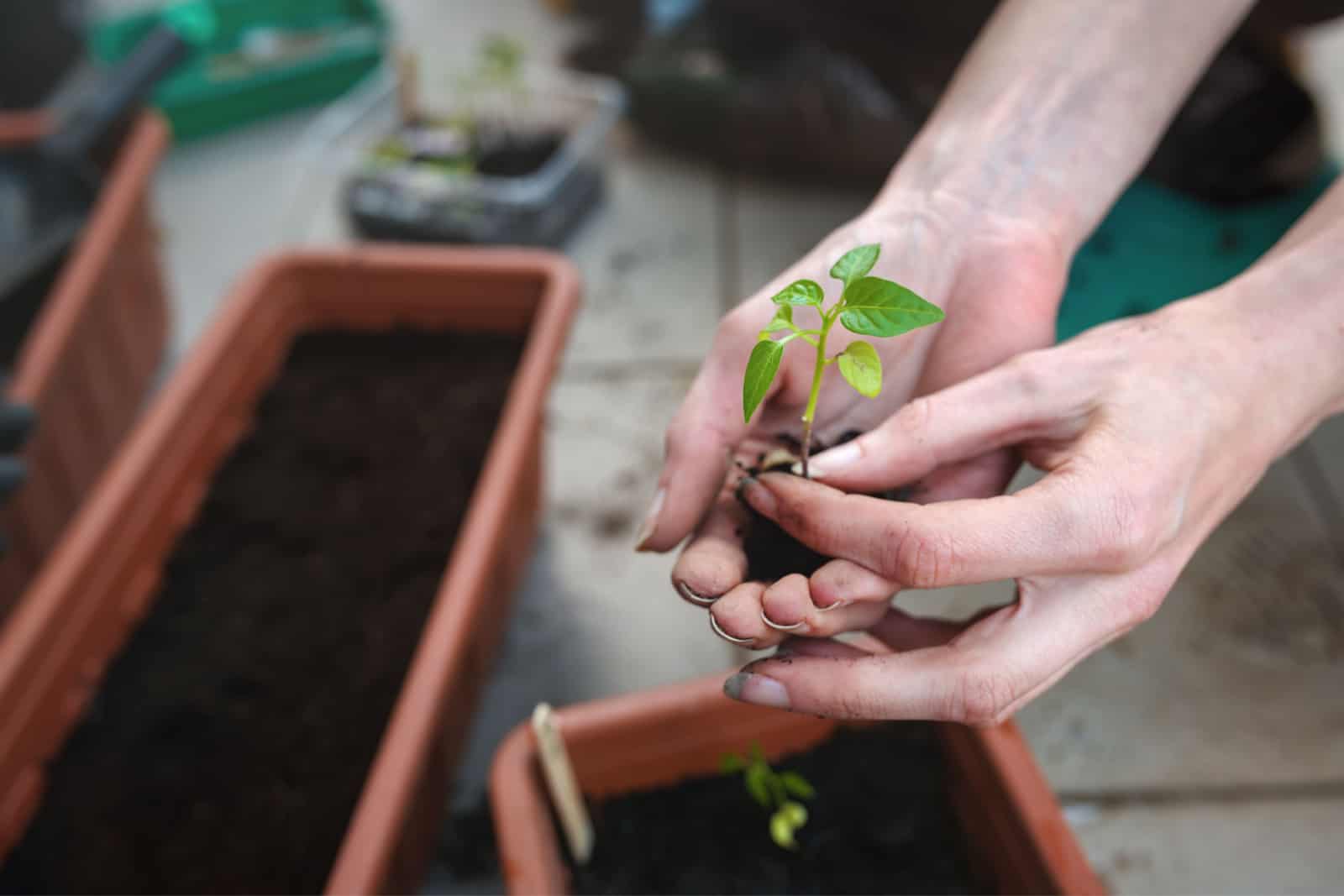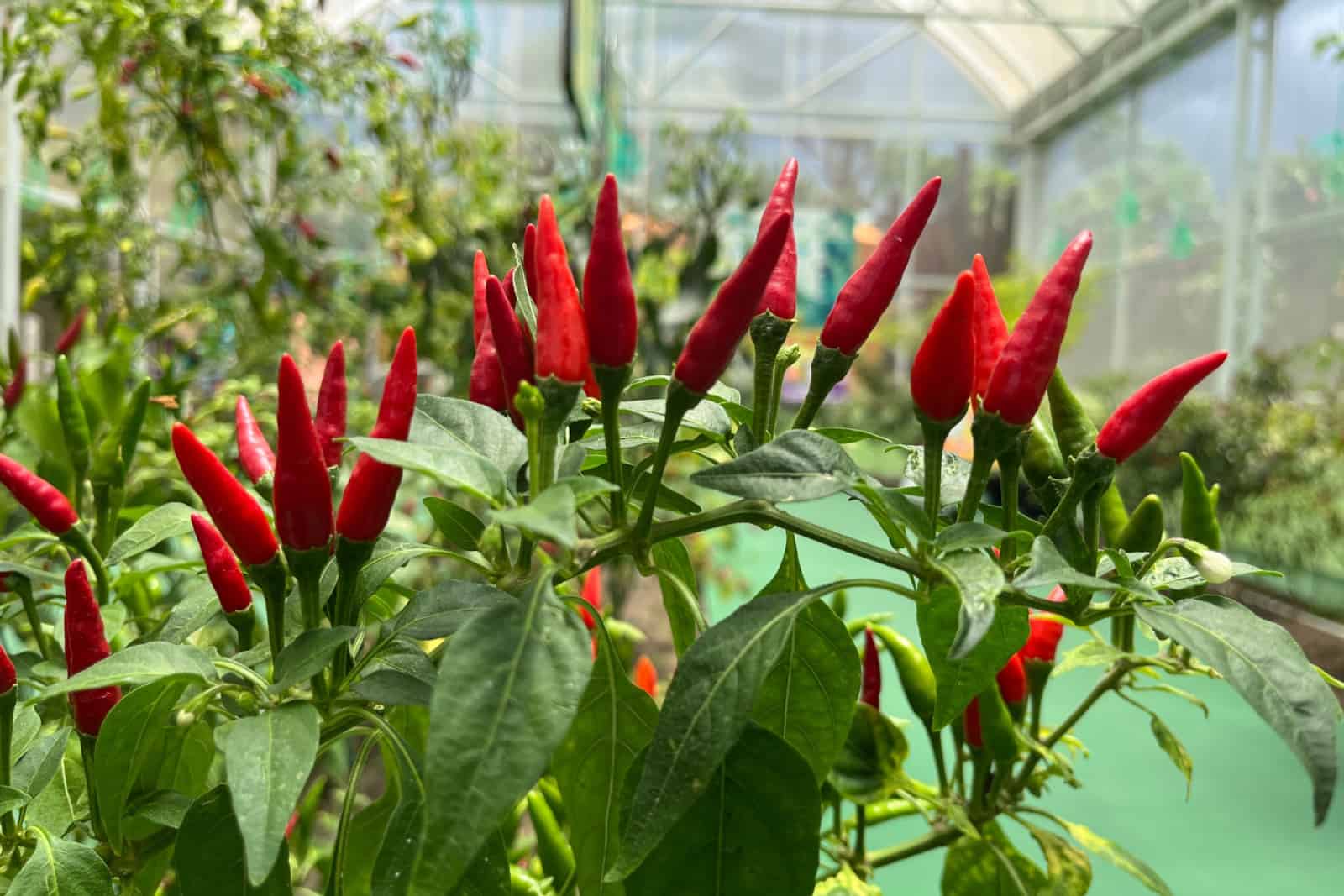Growing my own chillies has really improved the flavor of my hot sauces, chilli con carne, and everything else that requires some heat.
Today, I’m here to offer some advice on increasing your yield and getting as many peppers as possible.
One of the best ways to get a bountiful harvest is by using a suitable fertilizer for chilli plants, and that’s what I’m going to talk about today.
Unfortunately, there isn’t just one NPK that fits all plants, although the general rule is to use high-nitrogen fertilizer during the vegetative growth stage and high-potassium during the flowering stage.
Feed your plants as they grow, fertilize them 2-4 times per month, and that’s it! There’s a little more to it than that, but I’ll discuss all these things in more detail, including some of my favorite fertilizers, and also give you a tip or two on how to deal with overfertilization.
Let’s begin!
Fertilizer For Chilli Plants Nutrition
Chilli peppers require both macro and micronutrients to grow a lot of fruit, which is why it’s so important to adjust them as the plant matures.
Below, you can find more information on which nutrients are necessary and what percentages you’ll need to ensure in order to encourage a high yield.
NPK
The macronutrients that chillies need are nitrogen, phosphorus, and potassium. All these minerals have their benefits when it comes to plant growth, flowering, and fruit production.
For instance, nitrogen is usually regarded as a nutrient which increases vegetative growth. However, it can also increase the production of flower buds and flowering in general. (1)
Therefore, it is important to use fertilizers with a good amount of nitrogen all season long.
Don’t forget about phosphorus and potassium. These elements are especially important during the flowering stage, although using a small percentage of these minerals throughout the chillies’ growth cycle is beneficial.
Potassium is also proven to increase the yield and quality of nightshades such as chilli peppers, and also raise the amount of vitamin C. (2)
So, don’t be stingy with this nutrient!
However, it also depends on the type of soil you have. If you have a substrate with high-nitrogen levels, you might need to use 5-10-10. Or your plants might enjoy a balanced or low-phosphorus fertilizer, depending on the amount of this nutrient in the soil.
All I can tell you is to test your growing medium and experiment a bit until you find the perfect combination.
Other Nutrients
In addition to macronutrients, chilli peppers also need calcium, sulfur, and magnesium for proper growth.
Luckily, many fertilizers contain these minerals, so you don’t have to worry about deficiencies.
When To Start Fertilizing
Understanding all the chilli plant growing stages can help you determine when to start fertilizing them.
The basic rule is not to fertilize these plants during germination since that can potentially hinder their growth.
But why is that? Well, if you start your seeds indoors and use store-bought commercial mixes, it’s highly likely that they contain added plant food. And if you add more, you’ll just overfertilize the delicate seeds and slow down the entire process.
You should start fertilizing your peppers about 2-3 weeks after germination, which is when the plant develops true leaves.
However, use weak fertilizers diluted to half or quarter-strength at this stage. The seedlings don’t grow that fast and too many nutrients will damage their roots.
I don’t feed my young chillies until I transplant them into their final location. I grow them in a nutrient-rich environment up until that moment, so there’s no need for further fertilization.
How Often You Should Feed Your Chillies
Fertilizing seedlings is a tricky business, which is why you should be extra careful. Start off with a quarter of the recommended amount, but follow the manufacturer’s frequency. This usually means feeding your plants 2-4 times a month, depending on the fertilizer.
In about two months, you can increase the dosage and stick to the recommendations on the back of the package.
For instance, I move chilli plants outside once they develop a third set of true leaves, and I fertilize them every other week.
However, you can feed your plants every week if you have a less potent fertilizer or less fertile soil.
The Proper Way To Fertilize Chilli Plants
Feeding potted and in-ground chilli plants is slightly different, although they all have the same needs as seedlings.
Fertilize the young plants with a fish and seaweed plant food, but use a quarter of the suggested dosage to avoid overfertilization.
I use fertilizers with a 3-1-4 ratio before the plant starts flowering to help it develop more side shoots and keep it healthy.
Once the plant flowers and starts producing fruit, I switch to fertilizers with higher phosphorus and potassium content, although I try to keep nitrogen levels high as well. At this stage, I use 7-3-10 or a fertilizer with similar values.
As the plants continue to develop, you can incorporate some other fertilizers, such as Epsom salt. Dilute the salt in water and use the solution as a foliar spray to prevent magnesium and sulfur deficiency.
Here are some instructions for applying Epsom salt foliar spray:
Potted Chillies
Once the peppers become too big for their nursery pots, it is time to move them to larger containers.
At this stage, you’ll also want to increase the amount of fertilizer you give them. Simply start using half instead of a quarter of the recommended amount and see how your plants react.
Later on, you can include secondary nutrients into the mixture to promote healthy plant growth. I love to add calcium to prevent blossom end rot in the form of eggshell fertilizer, Cal-Mag, or bone meal.
Dilute the Cal-Mag in water according to the instructions or work some bone meal into the topsoil. Use these minerals every four weeks or so, and you won’t have to deal with blossom end rot or a lack of chilli fruit.
Once your chilli plants start to flower, you can introduce some fertilizer that enhances bloom production. FoxFarm’s products are great, but we’ll talk more about them in the next section.
In-Ground Chillies
If you’ve moved your chilli pepper plants from their small pots directly into the ground, you can use the recommended dosage as suggested on the package.
However, before transplanting this veggie to the ground, I like to amend the soil with compost to improve the texture and add some nutrients along the way. Compost also has a positive effect on the microbial life in the soil, improving its fertility and quality. (3)
The good news about growing chillies in the ground is that calcium deficiency is unlikely, so you won’t have to use fertilizers with this secondary nutrient.
9 Best Chilli Plant Fertilizers On The Market
No matter what type of chilli plants you have, there are some universal fertilizers that fit every size and variety.
Below, you can find some of my favorite fertilizers for chillies, some of which almost doubled my yield!
1. Espoma Organic Garden-Tone Herb & Vegetable Food
I love using this fertilizer for my potted chilli peppers, although it works perfectly well for in-ground ones as well.
This blend contains 5% calcium, which can prevent blossom end rot, and you won’t have to use any other source of this nutrient, saving you plenty of time.
Another thing I love about this plant food is that it contains 1% magnesium and 2% sulfur, so you don’t need to use Epsom salt fertilizer.
Also, its NPK value is 3-4-4, so it’s perfect for plants that have just started flowering and fruiting.
This blend doesn’t contain any toxins or sludges and is perfect for any organic garden!
Another great thing about this fertilizer is that it slowly releases nutrients, so you won’t have to use it more than once a month!
[table id=716 /]
2. FoxFarm Liquid Nutrient Trio Soil Formula
If you want to increase your chilli pepper yield, then you should be using these fertilizers.
There are three types of liquid plant food in this offer, and each of them is suitable for different stages.
Grow big is perfect for seedlings and plants that are still in the vegetative stage. As the plant continues to grow and develop, you can incorporate some Big Bloom because it isn’t too strong and won’t damage the chillies’ roots.
And once the buds and blossoms start appearing, switch to high-phosphorus Tiger Bloom to maximize the yield.
These liquid fertilizers release nutrients instantly, and you’ll quickly notice the difference. However, you will have to apply them more frequently!
[table id=717 /]
3. MiracleGro Shake ‘n Feed All Purpose Plant Food
MiracleGro is the king of gardening, so it’s not surprising that one of the best fertilizers for chilli plants belongs to this brand.
This particular plant food is suitable for various flowers and herbs, not just veggies.
It lasts for three months, so you won’t have to feed your chillies that often, and it works well for both potted and in-ground plants.
MiracleGro all purpose plant food comes with easy-to-follow instructions. My friend Jen loves this product since you don’t have to do any math; simply read the packaging and add what you need!
This product contains all the micronutrients your chillies will need, so you can forget about blossom end rot!
Its NPK value is 12-4-8, making it best for the vegetative growth stage!
Finally, this MiracleGro plant food contains bone and feather meal, kelp, and earthworm castings, so it also feeds the microbes in the soil. This allows it to promote the natural fertility of the soil.
[table id=718 /]
4. Neptune’s Harvest Fish & Seaweed Fertilizer
I love using this product for my peppers as it never causes root burn. I apply it once I notice chilli flowers appearing, although you can use it in the seedling stage as well.
Its NPK is 2-3-1, making it perfect for my blooming chillies.
This product is completely organic (it’s just blended fish and seaweed), so it’s suitable for all gardens.
And since it comes in liquid form, it releases nutrients instantly, allowing me to see the results immediately.
It doesn’t smell that great, but that’s actually a good thing when it comes to pests in outdoor gardens. Deer and rabbits hate the smell of this stuff, so you won’t have to worry about them nibbling on your chilli plants.
What’s more, you can use it as a foliar spray. However, I don’t do that very often since the smell is pungent. But if it’s going to rain, I apply it generously since the odor will be washed away anyway!
[table id=719 /]
5. Liqui-Dirt All Purpose Plant Food
My mom swears by this product. It contains all the micronutrients your chillies will need, so you won’t need any other product to increase your yield.
Its NPK value is 1.11-0.03-13.15, which makes it perfect for the flowering stage.
But what my ma loves about this fertilizer the most is the fact that it lasts for a really long time. You can make 6400 applications for all your veggies and flowers, which means it pays off in no time!
The mycorrhizal fungi that this product contains allows your plants to absorb more nutrients from the soil, resulting in greater plant health and growth. (4)
And if that’s not enough, this fertilizer is completely organic, doesn’t smell, is safe around your pets, and can be used for all mediums, including hydroponics.
It also releases nutrients immediately, making it easy for you to see the results at once!
[table id=720 /]
6. MiracleGro Shake ‘n Feed Tomato, Fruit & Vegetable Plant Food
Another MiracleGro product no gardener should be without! This fertilizer will slowly deliver nutrients, feeding your plants for up to three months. Therefore, you won’t have to spend a lot of time fertilizing your plants!
It also contains many micronutrients, including calcium, which can prevent blossom end rot just like that!
This makes it most suitable for container chillies, although in-ground plants love it just the same.
Additionally, this fertilizer feeds the microbial life underground due to the worm castings it contains. When these organisms are active, it increases the quality and fertility of the entire soil.
What most of my fellow gardeners say about this product is that it works great and doesn’t have a foul odor.
[table id=721 /]
7. Miracle-Gro Performance All Purpose Plant Nutrition Granules
This fast-release product will quickly show you the results you’ve been waiting for.
Its NPK is 9-2-7, so you can use it during the seedling and flowering stages – just be careful about the amounts you use.
These all purpose granules are perfect for both potted and in-ground chillies, as well as other herbs, flowers, and veggies.
You can safely use it in your vegetable garden as it is completely organic! Also, the shaker jug makes it easy to apply to containers.
Finally, it feeds for up to 4-6 weeks, reducing your fertilizing chores.
[table id=722 /]
8. Jobe’s Organics Vegetable & Tomato Granular Plant Food
Jobe’s Biozome are microorganisms that quickly decompose organic matter and improve the absorption of nutrients due to their mycorrhizal fungi content.
It improves soil quality and increases the chilli’s resistance to drought, insects, and diseases.
The NPK of this plant food is 2-5-3, so it’s perfect for chillies in the flowering stages when they need more phosphorus and potassium.
Use it to prepare the soil before planting or even for seedlings. It comes with easy-to-follow instructions!
This fertilizer also contains micronutrients, the most important of which is calcium because it prevents blossom end rot.
This product doesn’t contain any chemicals and is easy to use. However, since it’s completely organic, it doesn’t have the best smell.
[table id=723 /]
9. GS Plant Foods Organic Liquid Fish & Kelp Blend
This fertilizer is suitable for all plants, from chillies and other veggies and herbs to flowers and even lawns.
It’s organic, so you can use it in an all-natural garden, and since it’s a fish and seaweed plant food, it is most suitable for flowering chillies.
This fertilizer promotes healthy growth, increases the yield, and is easy to apply.
However, the one thing that’s bad about this product is the smell. If you want to make it easier to bear, don’t use it for your indoor plants and apply it before it rains.
[table id=724 /]
Homemade Fertilizers For Chilli Plants
If you’re not a fan of commercial fertilizer or you just like to get your hands dirty, there are a couple of homemade fertilizers for chilli plants you can try out.
For instance, if your soil lacks any of magnesium, calcium, or sulfur, it wouldn’t be a bad idea to replenish them. You can also use eggshells or bone meal to add more calcium to the substrate, or Epsom salt to replenish magnesium and sulfur.
My favorites are definitely bone meal and compost as they deliver all the necessary micronutrients, so there’s no need for additional fertilizers.
Bone Meal
If you make your own bone meal you’ll get yourself a homemade phosphorus fertilizer perfect for chillies in the flowering stage.
In addition to phosphorus, bone meal also contains plenty of calcium, so it can help avoid blossom end rot on your chilli plants and keep your yield high.
When using this plant food, work a handful into the top layer of the growing medium, mix it well, and you’re done!
Compost
Using compost and animal manure together with regular fertilizer can increase your chilli yield. (5)
If you make it yourself, you’ll save a couple of dollars too. Simply mix some green and brown materials such as kitchen scraps, grass clippings, old leaves, twigs, cardboard, etc. with some water, turn the mixture from time to time, and in as little as three months you’ll have your own compost.
You can use it on its own and add it directly to the soil or potting mix, or you can make compost tea. One of the reasons gardeners turn it into tea is because it delivers the nutrients more quickly.
Here are some simple tips for making compost tea:
What To Do With Overfertilized Chillies
Too much fertilizer in the soil can hurt or even kill your chillies, so make sure to always use the amount indicated on the package.
Even if you follow the instructions down to a T, you can still end up with overfertilized plants. Perhaps they don’t need too many nutrients or they’re just too young to handle it.
You’ll notice that your chillies don’t grow as fast, have fewer flowers and buds, or that their leaves are either yellow or have brown margins.
Whatever the reason, here are some tips for dealing with this issue:
1. Soil leaching – This method allows you to remove the excess nutrient salts from the garden soil. Simply irrigate your chillies thoroughly and the minerals will move downward with the water.
2. Soil flushing – This technique is the same as leaching but for potted plants. Use lukewarm water four times the volume of the container, slowly pour it in, and allow it to drain through the potholes.
3. Change the mix – This method also works for potted chillies. If you don’t have enough time to flush the soil, you can simply replace it with a new blend and lay off fertilizing for the time being.
Final Thoughts
We’ve finally reached the end! Now you know what the best fertilizer for chilli plants should have, how to use them, and, most importantly, when to use them.
Remember, seedlings don’t require the same plant food, or the same amount, as flowering chillies.
I included my favorite products that can increase your yield and presented some tips for using homemade fertilizers if you want your garden to be au naturale.
And last, but not least, I threw in a couple of tips for dealing with overfertilization. It happened to me, so it’s always better to be prepared.
Good luck, and until next time!
Meta: Check out these tips for choosing the best fertilizer for chilli plants, find some great products or make your own, and learn how to treat overfertilization.
References:
1. Pyero, J. O., Bhangoo, M. S., & Steiner, J. J. (1990). Nitrogen Fertilizer Management Practices to Enhance Seed Production by ‘Anaheim chilli’ Peppers. Journal of the American Society for Horticultural Science.
2. Wuzhong, N. (2002). Yield and Quality of Fruits of Solanaceous Crops as Affected by Potassium Fertilization. Better Crops International.
3. Knapp, B. A., Ros, M., & Insam, H. (2009). Do Composts Affect the Soil Microbial Community?. Microbes at Work.
4. Jeffries, P. (1987). Use of Mycorrhizae in Agriculture. Critical Reviews in Biotechnology.5. Anggraheni, Y. G. D., Nuro, F., & Paradisa, Y. B. (2019). Effect of Organic Fertilizer on Growth and Yield of chilli Pepper. Proceedings, The SATREPS Conference.


